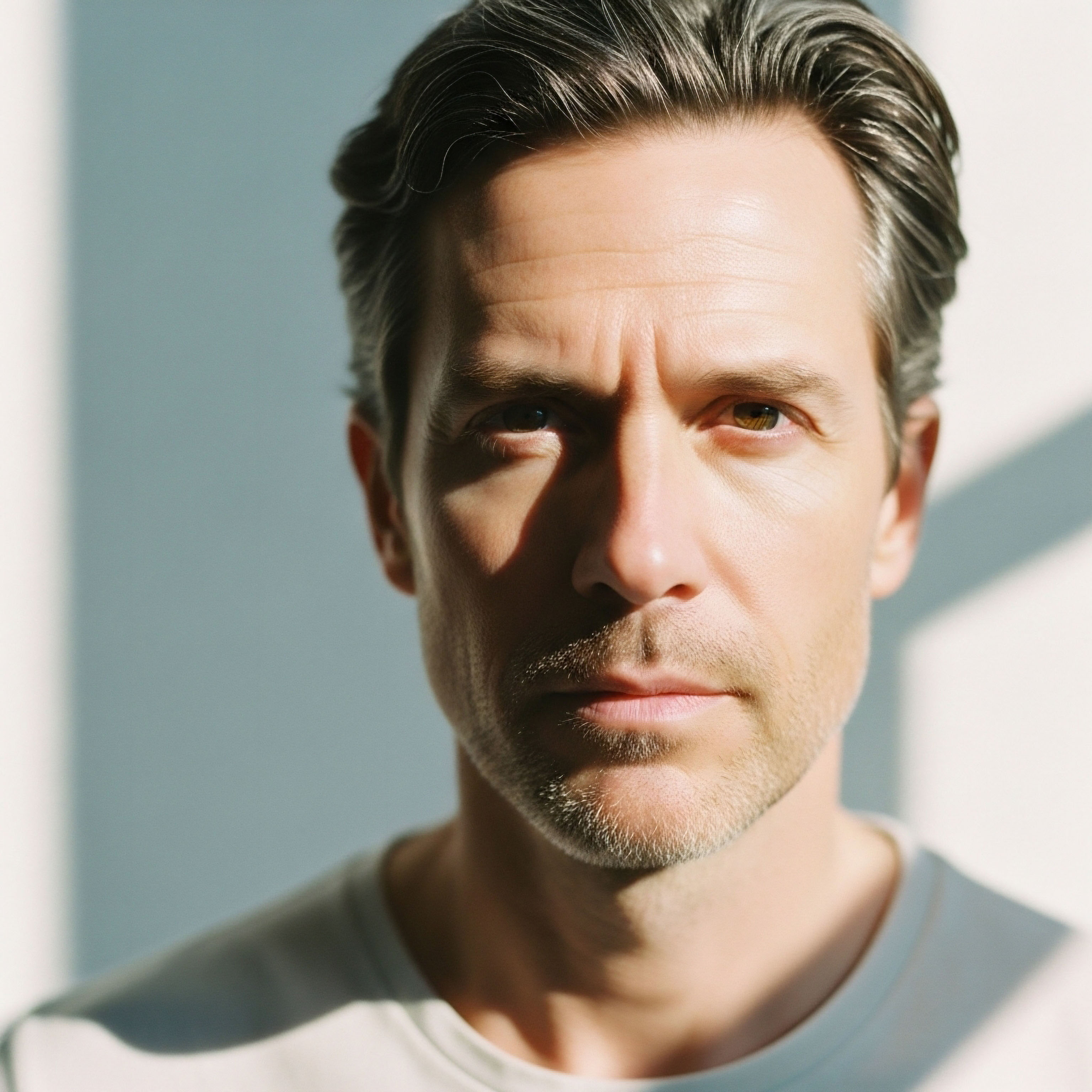

Fundamentals
The decision to begin a journey of hormonal optimization is often born from a place of profound personal need. You may have felt a gradual erosion of vitality, a dulling of the sharp edges of your focus, or a frustrating decline in physical performance that no amount of discipline in the gym or kitchen could seem to correct.
Initiating a protocol like testosterone replacement therapy (TRT) can feel like reclaiming a fundamental part of yourself. The energy returns, the mental clarity sharpens, and a sense of capability is restored. It is a powerful, validating experience.
Yet, for many men, a new and equally profound question eventually arises, one that shifts the focus from individual vitality to the potential for creating new life ∞ After turning to an external source to restore your own system, can you fully restart the intricate biological machinery required for fatherhood?
This question leads us directly to the core of male reproductive biology, a system of elegant communication known as the Hypothalamic-Pituitary-Gonadal (HPG) axis. Think of this as the body’s internal command and control center for reproductive function. The hypothalamus, a small but powerful region in the brain, acts as the chief executive.
It constantly monitors the body’s hormonal environment. When it senses that more testosterone is needed, it sends out a chemical memo called Gonadotropin-Releasing Hormone (GnRH). This memo travels a short distance to the pituitary gland, the senior manager of the operation. Upon receiving GnRH, the pituitary dispatches two critical instructional hormones into the bloodstream ∞ Luteinizing Hormone (LH) and Follicle-Stimulating Hormone (FSH).
These two hormones travel down to the testes, the operational floor of this entire enterprise. LH has a very specific job ∞ it signals a group of specialized cells, the Leydig cells, to produce testosterone. This is the primary source of the body’s own testosterone supply.
FSH, on the other hand, communicates with a different set of cells, the Sertoli cells. Sertoli cells are the direct nurturers of sperm production, a complex process called spermatogenesis. For spermatogenesis to occur efficiently, it requires two things ∞ the direct signal from FSH and a very high concentration of testosterone inside the testes, a concentration many times higher than what is found in the bloodstream.
The entire system is a finely tuned feedback loop. When testosterone levels in the blood rise, the hypothalamus and pituitary sense this, and they reduce their output of GnRH, LH, and FSH, keeping the system in a state of dynamic balance.
The introduction of external testosterone interrupts the body’s natural hormonal dialogue, leading to a functional pause in sperm production.
When you begin testosterone replacement therapy, you are introducing testosterone from an external source. Your body, in its immense wisdom and efficiency, recognizes the presence of this abundant testosterone. The hypothalamus and pituitary gland see that testosterone levels are sufficient, so they cease sending their signals.
The release of GnRH slows, which in turn shuts down the production of LH and FSH. Without the LH signal, the Leydig cells in the testes stop their own testosterone production. Without the FSH signal, and without that high local concentration of intratesticular testosterone, the Sertoli cells pause the process of spermatogenesis.
The machinery of sperm production grinds to a halt. This is a normal, predictable, and functional response of the HPG axis. The system is working exactly as it is designed to, by downregulating its own production in the face of external supply.
The central question of restoring fertility, therefore, is about restarting this entire communication chain. It is about convincing the hypothalamus to once again send its GnRH memo, prompting the pituitary to dispatch LH and FSH, and waking up the dormant machinery within the testes.
The process of sperm development itself is a lengthy biological cycle, taking approximately 74 days from the initial stem cell to a fully mature spermatozoon. This timeline is a biological constant. Any successful restoration protocol must respect this inherent pacing. The goal is to re-establish the body’s own signaling cascade, allowing this intricate process to resume its natural course.
The possibility of restoration is rooted in the inherent plasticity of the endocrine system. The shutdown is, in most cases, a functional state, and the components of the HPG axis retain their capacity to respond once the correct stimuli are reintroduced.


Intermediate
Understanding that fertility can be restored is the first step. The next is to comprehend the clinical strategies used to actively manage and accelerate this process. For the man who wishes to transition from a state of hormonal support back to endogenous production for the purpose of conception, the journey is a well-defined clinical path.
This path involves a sequence of steps designed to systematically re-engage the Hypothalamic-Pituitary-Gonadal (HPG) axis. It requires patience and a close partnership with a knowledgeable clinician to monitor and adjust the protocol based on your unique biological response.

The Cessation Phase and the Symptomatic Bridge
The initial step is, quite simply, the cessation of all exogenous testosterone administration. This “washout” period is critical. Depending on the ester of testosterone used (e.g. cypionate, enanthate), it can take several weeks for the synthetic hormone to clear from your system.
During this time, you will likely experience a period where both external and internal testosterone levels are very low. This can be a challenging phase, as the symptoms of hypogonadism that originally prompted therapy may return. Fatigue, low mood, and reduced cognitive function are common experiences.
It is vital to view this as a temporary and necessary bridge to the next phase of active restoration. Validating this experience is key; the discomfort is a direct indicator that the system is being prepared for a reboot.

Active Restoration Protocols a Multi-Pronged Approach
Once exogenous testosterone has cleared, a clinician will typically initiate a “Post-TRT” or fertility-stimulating protocol. This is not a passive waiting game. It involves using specific pharmaceutical agents to actively stimulate the HPG axis at different points in its feedback loop. The standard of care often involves a combination of medications, each with a distinct role.

Human Chorionic Gonadotropin (hCG) the Leydig Cell Stimulator
Human Chorionic Gonadotropin, or hCG, is a cornerstone of fertility restoration. This injectable medication is structurally very similar to Luteinizing Hormone (LH). It functions as a powerful LH analogue, binding directly to the LH receptors on the Leydig cells within the testes. This provides the direct signal for these cells to resume their primary function ∞ producing testosterone.
The re-establishment of high intratesticular testosterone is a critical prerequisite for spermatogenesis. Clinical protocols often utilize doses such as 3,000 international units (IU) injected subcutaneously every other day. This approach effectively bypasses the dormant hypothalamus and pituitary, directly stimulating the testes to “wake up” and begin production. It is the foundational step in restarting the local environment required for sperm creation.

Selective Estrogen Receptor Modulators (SERMs) Re-Engaging the Brain
While hCG directly stimulates the testes, the next step is to encourage the brain to resume its own signaling. This is where Selective Estrogen Receptor Modulators (SERMs) like Clomiphene Citrate (Clomid) or Enclomiphene come into play. These oral medications have a clever mechanism.
The hypothalamus has estrogen receptors that it uses as part of its feedback monitoring system. SERMs work by blocking these receptors in the hypothalamus. This action effectively makes the brain “blind” to the circulating estrogen in the body.
Interpreting this lack of an estrogen signal as a sign that hormone levels are too low, the hypothalamus responds by increasing its output of Gonadotropin-Releasing Hormone (GnRH). This, in turn, stimulates the pituitary to produce and release both LH and FSH, re-establishing the body’s own complete signaling cascade.
Enclomiphene is a more refined isomer of clomiphene and is often preferred as it carries fewer side effects, such as mood changes or visual disturbances, that can be associated with clomiphene.
Successful fertility restoration hinges on a dual strategy of directly stimulating the testes while simultaneously restarting the brain’s own hormonal signaling.
The table below outlines the primary medications used in a typical post-TRT fertility protocol, highlighting their mechanism and primary role in the restoration process.
| Medication | Class | Primary Mechanism of Action | Therapeutic Goal |
|---|---|---|---|
|
hCG (Human Chorionic Gonadotropin) |
LH Analogue |
Directly stimulates the LH receptors on Leydig cells in the testes. |
To increase intratesticular testosterone production and testicular volume. |
|
Clomiphene Citrate / Enclomiphene |
SERM |
Blocks estrogen receptors in the hypothalamus, increasing GnRH release. |
To stimulate the pituitary’s natural production of LH and FSH. |
|
Anastrozole |
Aromatase Inhibitor |
Blocks the conversion of testosterone to estrogen in peripheral tissues. |
To manage estrogen levels and prevent potential side effects from hCG therapy. |
|
GnRH Analogue |
Provides a direct, pulsatile stimulus to the pituitary gland. |
To directly prompt the release of LH and FSH from the pituitary. |

Monitoring Progress and Setting Realistic Timelines
The journey to restored fertility is a biological process that cannot be rushed. Clinical monitoring is essential. This involves regular blood tests to track levels of total and free testosterone, LH, FSH, and estradiol. Just as importantly, it requires periodic semen analysis to measure sperm count, motility, and morphology. These objective measures provide clear feedback on the protocol’s effectiveness and guide any necessary adjustments.
Research and clinical experience provide a general timeline for what to expect. A significant percentage of men will see a return of sperm to their ejaculate within 6 to 12 months. For some, particularly those on TRT for very long durations or at high doses, the process can take up to two years. In a small number of cases, fertility may not be fully restored. Factors that can influence the timeline include:
- Duration of TRT ∞ Longer periods of suppression may require a longer time for recovery.
- Age ∞ While recovery is possible at any age, younger men may see a faster return of function.
- Baseline Fertility ∞ Pre-existing fertility issues can affect the outcome.
- Dosage of Testosterone Used ∞ Higher doses of androgens can cause a more profound suppression.
The process requires a commitment to the protocol and a clear understanding that the timeline is dictated by the body’s own pace of healing and recalibration.


Academic
A sophisticated examination of fertility restoration after prolonged androgen administration moves beyond clinical protocols into the realm of cellular physiology and endocrine network dynamics. The central biological insult is the sustained suppression of the hypothalamic-pituitary-gonadal (HPG) axis, which induces a state of hypogonadotropic hypogonadism.
While clinically reversible for most individuals, the completeness and timeline of recovery are predicated on the functional integrity of the underlying cellular machinery, particularly the Leydig and Sertoli cells of the testes, and the plasticity of the neuroendocrine control systems in the brain.

Cellular Consequences of Prolonged HPG Axis Suppression
The administration of exogenous testosterone leads to a profound reduction in circulating gonadotropins, LH and FSH. This has direct and measurable consequences on testicular histology and function. Leydig cells, which are dependent on LH for steroidogenesis, undergo a process of dedifferentiation and atrophy. Their numbers may decrease, and their capacity for testosterone production becomes quiescent. This is a functional adaptation to the lack of trophic support from LH.
Simultaneously, the Sertoli cells, which form the architectural and nutritional foundation of the seminiferous tubules, are impacted by the dual loss of FSH stimulation and the dramatic reduction in intratesticular testosterone (ITT). High ITT is absolutely essential for the progression of spermatogonia through meiosis and spermiogenesis.
Without it, the process arrests, leading to oligospermia (low sperm count) or complete azoospermia (absence of sperm). Prolonged suppression can lead to a reduction in seminiferous tubule diameter and a disorganization of the germinal epithelium. The resilience of the spermatogonial stem cell population is a key determinant of the potential for recovery. In most cases, these stem cells remain viable, awaiting the appropriate hormonal signals to reinitiate proliferation and differentiation.

Pharmacological Interventions a Mechanistic Analysis
The therapeutic strategies employed for fertility restoration are designed to systematically reactivate the suppressed HPG axis. A deeper look at these agents reveals their precise roles.
- hCG and Intratesticular Testosterone ∞ Human Chorionic Gonadotropin acts as a direct LH receptor agonist. Its administration rapidly restores Leydig cell function and elevates ITT to the supraphysiological levels required for spermatogenesis. Research has demonstrated that concomitant use of low-dose hCG during TRT can maintain ITT and preserve spermatogenesis, suggesting its protective role. In a post-TRT setting, its function is purely restorative, providing the foundational steroidogenic stimulus for the testes.
- SERMs and Neuroendocrine Reactivation ∞ Clomiphene citrate and its more targeted isomer, enclomiphene, function as competitive antagonists at hypothalamic estrogen receptors. This blockade disrupts the negative feedback signal that estrogen exerts on GnRH release. The resulting increase in pulsatile GnRH secretion from the hypothalamus is the primary event that drives the recovery of endogenous pituitary function, leading to the release of both LH and FSH. The choice between clomiphene and enclomiphene often comes down to side effect profiles, as enclomiphene lacks the estrogenic agonist effects seen in other tissues that are associated with clomiphene’s adverse effects.
- Recombinant FSH (rFSH) ∞ In cases where SERM therapy fails to adequately elevate FSH levels, or for patients with a more profound suppression, direct administration of recombinant FSH can be employed. This provides the specific signal needed by Sertoli cells to support the maturation of developing sperm. Studies combining hCG and FSH have shown efficacy in restoring spermatogenesis even in difficult cases, demonstrating that providing both gonadotropic signals directly can overcome persistent suppression.

What Is the True Predictor of Successful Spermatogenesis Recovery?
The variability in recovery times among individuals points to a multifactorial process. Research has identified several key predictors that influence the probability and timeline of restoring spermatogenesis.
| Factor | Influence on Recovery | Underlying Mechanism |
|---|---|---|
|
Duration of Androgen Use |
Longer duration is associated with a longer recovery time. |
Prolonged suppression may lead to more significant Leydig and Sertoli cell atrophy, requiring a longer period of trophic support for functional restoration. |
|
Patient Age |
Younger age is generally associated with faster and more complete recovery. |
Age-related decline in testicular function and spermatogonial stem cell reserve may contribute to a slower response to stimulation. |
|
Baseline Semen Parameters |
Higher baseline sperm count before TRT correlates with better outcomes. |
Indicates a more robust underlying testicular function and reserve prior to suppression. |
|
Type and Dose of Androgen |
Higher doses and certain types of anabolic steroids cause more profound suppression. |
Greater suppression of the HPG axis requires a more aggressive and potentially longer restorative protocol. |
The recovery of fertility is ultimately governed by the endocrine system’s capacity for plasticity and the viability of testicular stem cells after a period of induced quiescence.
From a systems biology perspective, the HPG axis does not operate in isolation. Its function is modulated by metabolic health, stress physiology, and systemic inflammation. For instance, insulin resistance can negatively impact pituitary function and testicular steroidogenesis. Similarly, chronic elevation of cortisol from stress can have a suppressive effect on the HPG axis, potentially complicating recovery efforts.
A truly comprehensive academic view recognizes that optimizing these interconnected systems can create a more favorable biological environment for the HPG axis to recalibrate and restore its function. The success of fertility restoration protocols is a testament to the resilience of the male reproductive system and our growing understanding of its intricate regulatory networks.

References
- Wenker, Evan P. et al. “The Use of HCG-Based Combination Therapy for Recovery of Spermatogenesis after Testosterone Use.” The Journal of Sexual Medicine, vol. 12, no. 6, 2015, pp. 1334 ∞ 1337.
- Ramasamy, Ranjith, et al. “Recovery of Spermatogenesis Following Testosterone Replacement Therapy or Anabolic-Androgenic Steroid Use.” Translational Andrology and Urology, vol. 5, no. 5, 2016, pp. 713 ∞ 719.
- El Meliegy, Amr, et al. “Clomiphene Citrate and Human Chorionic Gonadotropin Are Both Effective in Restoring Testosterone in Hypogonadism ∞ A Short-Course Randomized Study.” BJU International, vol. 122, no. 5, 2018, pp. 889-897.
- Hsieh, Tung-Chin, et al. “Concomitant Intramuscular Human Chorionic Gonadotropin Preserves Spermatogenesis in Men Undergoing Testosterone Replacement Therapy.” The Journal of Urology, vol. 189, no. 2, 2013, pp. 647 ∞ 650.
- Coviello, Andrea D. et al. “Low-Dose Human Chorionic Gonadotropin Maintains Intratesticular Testosterone in Normal Men with Testosterone-Induced Gonadotropin Suppression.” The Journal of Clinical Endocrinology & Metabolism, vol. 90, no. 5, 2005, pp. 2595 ∞ 2602.
- Kohn, Taylor P. et al. “Age and Duration of Testosterone Therapy Predict Time to Return of Sperm Count After Human Chorionic Gonadotropin Therapy.” Fertility and Sterility, vol. 107, no. 2, 2017, pp. 351-357.e1.
- La Vignera, Sandro, et al. “Recovery of Spermatogenesis After Androgenic Anabolic Steroids Abuse in Men. A Systematic Review of the Literature.” Actas Urológicas Españolas (English Edition), vol. 48, no. 2, 2024, pp. 116-124.
- Bui, H. N. et al. “Evaluating the Combination of Human Chorionic Gonadotropin and Clomiphene Citrate in Treatment of Male Hypogonadotropic Hypogonadism ∞ A Prospective Study.” Andrology, vol. 8, no. 6, 2020, pp. 1643-1649.

Reflection
The clinical data and biological pathways provide a clear map for the journey back to fertility. We have seen how the body’s intricate hormonal conversation can be paused and then purposefully restarted. The protocols, the timelines, and the mechanisms offer a framework for what is possible.
Yet, beyond the science lies a deeply personal process of recalibration. This journey invites you to look at your own biology not as a fixed state, but as a dynamic system that you can learn to work with.
The knowledge you have gained is more than just information; it is a tool for agency. It allows you to ask informed questions and to understand the ‘why’ behind the clinical choices you and your physician make together. This process asks for a unique kind of patience ∞ one grounded in an appreciation for the body’s own timeline.
It is a partnership with your own physiology. As you move forward, consider what this journey means for your broader definition of health. How does understanding this one intricate system change the way you view the interconnectedness of your own well-being? The path to creating a family begins with this deeper understanding of yourself, transforming a clinical process into a profound act of personal restoration.

Glossary

testosterone replacement therapy

leydig cells

spermatogenesis

sertoli cells

testosterone replacement

intratesticular testosterone

hpg axis

human chorionic gonadotropin

fertility restoration

selective estrogen receptor modulators

clomiphene citrate

gonadorelin

sperm count

more profound suppression

azoospermia




